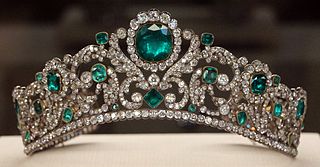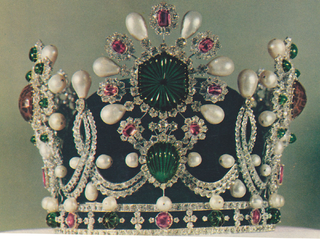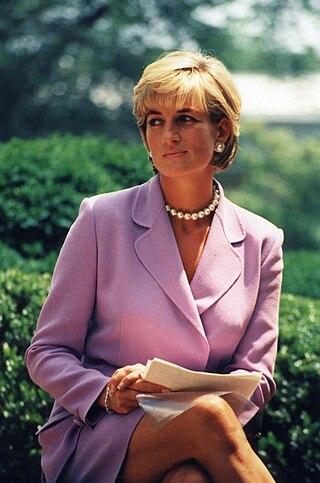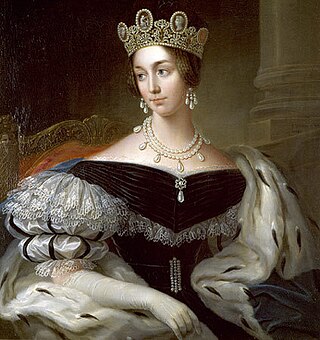
The Marie Louise Diadem is a diamond and turquoise diadem on permanent display at the National Museum of Natural History in Washington D.C.. It is named for Marie Louise of Austria, the wife of Emperor Napoleon of France.

The Marie Louise Diadem is a diamond and turquoise diadem on permanent display at the National Museum of Natural History in Washington D.C.. It is named for Marie Louise of Austria, the wife of Emperor Napoleon of France.
The design of the diadem's shell is very typical of Marie-Étienne Nitot's work from the period. A closed circle in shape, the diadem is left-right symmetrical, broadest in the front and narrowing towards the rear. Nitot made elaborate use of scrollwork, medallions, as well as palmettes and other floral motifs, rendered in silver and gold. In this it is similar to diadems and tiaras he produced for Marie-Thérèse, Duchess of Angoulême and Princess Augusta of Bavaria. The centrepiece at the front of the diadem was originally a single large square-cut emerald, aligned with one of its diagonals along the median line, which weighed 12 carats (2.4 g). A smaller oval-cut emerald was placed directly below the largest stone, and was in turn framed by five smaller rose-cut emeralds. Surrounding the centrepiece is a single layer of rose-cut white diamonds. Twenty large emeralds were set into the symmetrical floral and scrollwork decorations, cut in oval and briolette forms, and fifty-two smaller rose-cut and square-cut emeralds, also framed by a mix of rose-cut and brilliant-cut diamonds. The band that forms the base of the diadem is decorated with an unbroken single row of rose-cut diamonds.
In total, the Marie Louise Diadem held seventy-nine Colombian emeralds 'of the highest quality', sourced from the mines of Muzo, along with 1,002 brilliant-cut and 264 rose-cut diamonds of various sizes [1] totalling more than 700 carats (140 g) in weight. The seventy-nine emeralds were later removed and replaced with the same number of Iranian turquoise stones, mostly cut as cabochons rather than faceted like the original emeralds. The turquoise replacement stones weigh a total of 540 carats (108 g).

Tradition dictated that a royal bride coming to France must keep nothing of her homeland, especially her clothes. Accordingly, when Marie Louise of Austria arrived in France to marry Emperor Napoleon, she was stripped of her dress, corset, stockings, and chemise, leaving her completely naked. Pauline Bonaparte, Napoleon's sister, then made the nude teenager take a bath. She was then redressed in only the clothes and jewels purchased for her by her new husband. [2] As such, with no jewelry of her own, Marie Louise needed an entire new set produced for her. Among these were a pair of parures, one in diamond and opal, one in diamond and emerald. It is to the latter set that the later-named Marie Louise Diadem belonged. Both sets were given to Marie Louise to keep as part of her personal collection. As such, when she left Paris for Vienna after Napoleon's exile, she took the diadem and its associated jewelry pieces with her, where the crown jewels were left behind.
The diadem was designed by Marie-Étienne Nitot, the official court jeweler of Emperor Napoleon, and produced by his company in Paris, The House of Chaumet. Nitot had been commissioned to create several other pieces for the Emperor in the past, including Napoleon's papal tiara, his coronation crown, his ceremonial sword and the wedding jewels of his first wife, Josephine de Beauharnais. In this case, the commissioned diadem was to be the centrepiece of a parure for Napoleon's second wife, Marie Louise of Austria. The parure also included matching earrings, a necklace, a comb tiara and a belt buckle, all designed in silver and gold, decorated with emeralds and diamonds, and using the same stylistic flourishes. Marie Louise wore the set on several state occasions.
There is some disagreement over the exact date the diadem was presented to Marie Louise. The jewelers Van Cleef & Arpels, who purchased the diadem in the mid 20th century, reported to Life magazine that Napoleon had gifted the diamond and emerald parure to her in celebration of the birth of her son, Napoléon François Joseph Charles Bonaparte, in 1811. [3] Both the Smithsonian Institution and the Louvre, who later owned pieces from the parure, put the gift as being presented on the day of the imperial wedding in 1810. [4] [5] Of mixed use as circumstantial evidence of the latter theory, a portrait of Marie Louise wearing a diadem of the design was painted by Jean-Baptiste Isabey in 1810 (see right). However, the painter may not have been working from life, as the painting depicts the diadem as holding rubies instead of emeralds.
Upon Marie Louise's death in 1847, her jewels were divided among her Habsburg relatives, her son having pre-deceased her. There is some disagreement over the exact path down the family tree that the diadem and its parure took:
The reason for the unclear provenance between Marie Louise and Albrecht lies in the loss of the family's papers and documentation when Albrecht and his family fled Poland after being interned by Nazi Germany in World War II. After his death in Stockholm in 1951, Albrecht's widow (Alice Habsburg) and son (Archduke Karl Stefan of Austria) began the process of selling the family jewels, including the diadem, to various jewelers. However, with the documentation for the jewels lost during the flight from Poland, finding buyers proved difficult.
Eventually, the New York-based jewelry firm Van Cleef & Arpels purchased the Marie Louise Diadem and its matching belt buckle from the family in 1953, accepting the signed affidavit of both Alice and Karl Stefan attesting to the jewels' long history within the family and the claimed original provenance. The remaining pieces of the parure were later sold separately by the family in private sales. Van Cleef & Arpels put both the diadem and belt buckle on display in the window of their New York store. At some point after, the firm took them down from display to remove the emeralds from both and re-set them into individual pieces of jewelry. The largest of the emeralds were divided amongst six pieces—two sets of earrings, a bracelet, a ring, a clip, and a necklace. These used platinum settings and more modern brilliant cut diamonds, and were valued as a set at around $1m. The smaller emeralds from the diadem were mounted piecemeal into individual pieces and sold at various price points, some as low as $300, advertised as "emeralds from the historic Napoleon Tiara." [3] Following the article/advertisement of the emeralds in Life magazine in January 1955, Van Cleef & Arpels' secretary, Fred Vermont, told the United Press, "In 24 hours, we were sold out of emeralds. And we are still flooded with orders…letters and telegrams from all over the country." [6]
One such brooch, set with nine of the diadem's emeralds, has been put up for auction at Christie's several times since its original purchase; it sold for $178,500 in 1999, [7] and again for $450,000 in 2014. [8]
As each emerald was sold, Van Cleef & Arpels replaced it in the original diadem with turquoise sourced from Iran (then Persia). Jeffrey Edward Post, Curator of the U.S. National Gem and Mineral Collection, speculates that turquoise was chosen as it was relatively inexpensive and easy to shape to match the original settings, [9] while the Louvre claim it was done by request of Marjorie Merriweather Post. [5] It was with these new stones that the diadem was put on display in the Louvre in 1962, alongside the necklace, earrings and comb tiara from the original parure, as part of the 'Dix Siecles de Joaillerie Francaise' exhibition, celebrating French jewelry from the past millennium. The Louvre went on to purchase the necklace and earrings from their owners in 2004 for €3.7m, the highest price ever paid by a museum for individual pieces of jewelry. They remain on display in the Galerie d’Apollon. [1]
The Marie Louise Diadem was returned to Van Cleef & Arpels after the 1962 exhibition. They lent it out to Marjorie Merriweather Post to wear to a fundraising ball for the Red Cross in Palm Beach, Florida in 1967, where it received a great amount of acclaim. [9] When the firm later wrote to Post in 1971 offering her the opportunity to buy the diadem through a private sale before they began looking for clients, she donated the requested funds to the Smithsonian Institution to allow them to purchase it at the stated price.
The Smithsonian Institution have had the diadem on display in the National Museum of Natural History ever since, in the Janet Hooker Hall of Gems and Geology. It was temporarily removed from its shared display alongside the Napoleon Diamond Necklace for several months in the 1990s while the diadem was passed to a conservator-restorer for restoration. During that restoration, the antique frame was disassembled, cleaned, and re-assembled, with damaged portions soldered. After facilitating the purchase, Post inquired about the possibility of replacing the turquoise with emeralds once again, either artificial or—if possible to collect from their new owners—the original gemstones themselves. The fragility of the diadem precluded any further replacement, however. [9]

A tiara is a jeweled head ornament. Its origins date back to ancient Greece and Rome. In the late 18th century, the tiara came into fashion in Europe as a prestigious piece of jewelry to be worn by women at formal occasions. The basic shape of the modern tiara is a (semi-)circle, usually made of silver, gold or platinum, and richly decorated with precious stones, pearls or cameos.

The French Crown Jewels comprise the crowns, orb, sceptres, diadems and jewels that were symbols of Royal power between 752 and 1825. These were worn by many Kings and Queens of France as well as Emperor Napoleon. The set was finally broken up, with most of it sold off in 1885 by the Third Republic. The surviving French Crown Jewels, principally a set of historic crowns, diadems and parures, are mainly on display in the Galerie d'Apollon of the Louvre, France's premier museum and former royal palace, together with the Regent Diamond, the Sancy Diamond and the 105-carat (21.0 g) Côte-de-Bretagne red spinel, carved into the form of a dragon. In addition, some gemstones and jewels are on display in the Treasury vault of the Mineralogy gallery in the National Museum of Natural History.

Van Cleef & Arpels is a French luxury jewelry company. It was founded in 1896 by the Dutch diamond-cutter Alfred Van Cleef and his father-in-law Salomon Arpels in Paris. Their pieces often feature flowers, animals, and fairies, and have been worn by style icons and royalty such as Grace Kelly, Jacqueline Kennedy Onassis, Diana, Princess of Wales, Ava Gardner, Farah Pahlavi, Eva Perón, Elizabeth Taylor, the Duchess of Windsor and Queen Nazli of Egypt.

The Regent Diamond is a 140.64-carat (28.128 g) diamond owned by the French state and on display in the Louvre, worth as of 2015 £48,000,000.

A parure is a set of various items of matching jewelry, which rose to popularity in early 19th-century Europe.

Harry Winston was an American jeweler. He donated the Hope Diamond to the Smithsonian Institution in 1958 after owning it for a decade. He also traded the Portuguese Diamond to the Smithsonian in 1963 in exchange for 3,800 carats of small diamonds.

The House of Chaumet, founded in 1780, is a jeweller based in Paris.

Marie-Étienne Nitot was a French jeweller, the official jeweller to the Emperor Napoleon, and the founder of the House of Chaumet.

The Empress's Crown is part of the coronation regalia used by the only Shahbanu (Empress) of Iran, Farah Pahlavi. The crown is part of the Iranian National Jewels, and is currently on display at the Treasury of National Jewels in Tehran.

Queen Elizabeth II owned a historic collection of jewels – some as monarch and others as a private individual. They are separate from the gems and jewels of the Royal Collection, and from the coronation and state regalia that make up the Crown Jewels.

The Maharaja of Indore Necklace is a diamond and emerald-studded necklace. As of 2008, it is on display at the National Museum of Natural History in Washington, D.C., United States. It was originally named the Spanish Inquisition Necklace by the American jeweller Harry Winston, though it had no known connection with the historical Spanish Inquisition. The name was changed in 2021 by the Smithsonian Institution to reflect its actual provenance, having been first owned by Tukoji Rao III, Maharaja of Indore in the early 20th century.

The Napoleon Diamond Necklace is a diamond necklace commissioned by Napoleon I of France c. 1811–1812 from the Parisian jeweler Marie-Étienne Nitot. It is currently on display in the Smithsonian National Museum of Natural History in Washington, D.C..
Alexandre Reza was a Paris-based jeweler known for his diverse and rare collection of precious gemstones. He is lauded as the greatest gem collector of modern times.

The Portuguese crown jewels, also known as the Royal Treasure, are the pieces of jewelry, regalia, and vestments that were used by the Kings and Queens of Portugal during the time of the Portuguese Monarchy. Over the nine centuries of Portuguese history, the Portuguese crown jewels have lost and gained many pieces. Most of the current set of the Portuguese crown jewels are from the reigns of King João VI and King Luís I.

The Diadem of the Stars is a Diamond Tiara originally commissioned by Queen Consort Maria Pia of Savoy, who had a love for jewellery and fashion. It is a piece of the Portuguese Crown Jewels.

Diana, Princess of Wales, the first wife of Prince Charles, and mother of Prince William and Prince Harry, owned a collection of jewels, both as a member of the British royal family and as a private individual. These were separate from the coronation and state regalia of the Crown Jewels. Most of her jewels were either presents from foreign royalty, on loan from Elizabeth II, wedding presents, purchased by Diana herself, or heirlooms belonging to the Spencer family.

Jewelry of the Swedish Royal Family is the set of ceremonial jewels been owned by members of the Swedish royal family or by the Bernadotte family foundations. The Swedish national regalia, which have a symbolic meaning and are not to be regarded as jewelry, are, on the other hand, owned by the Swedish state.

Jewels! The Glitter of the Russian Court was the second jubileum exhibition in Amsterdam by the Hermitage Amsterdam, focussed on the personal taste for luxury by Russian nobility. The show, which was planned to run from 14 September 2019 to 15 March 2020, suffered from the pandemic and was extended twice, ending finally 16 October 2020.
Oscar Massin (1829–1913) was a Belgian-born French jeweler known as “The Diamond Reformer," who created some of the 19th centuries most influential and innovative fine jewelry that radically redefined a new era for the industry at large. While Massin remains one of the least-known Parisian jewelers, he produced some of the most significant works of his time, many for European royalty. Massin is celebrated for his patented diamond lacework technique, which uses filigree to create the illusion of woven metal. Massin is also credited with creating the first “illusory” setting, designed to emphasize the size of the diamond by minimizing the metal around it.

The Marie Antoinette Diamond Earrings are a pair of diamond earrings on permanent display in the Smithsonian National Museum of Natural History in Washington, D.C., United States. They are so named for their assumed provenance: that they were commissioned by King Louis XVI of France for his wife, Queen Marie Antoinette. While there is limited documentation and circumstantial evidence attesting to the truth of this claim, the origin of the earrings has never been definitively proven.